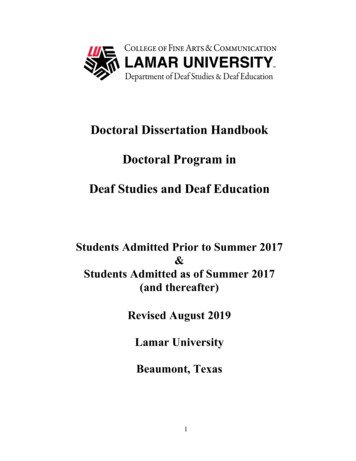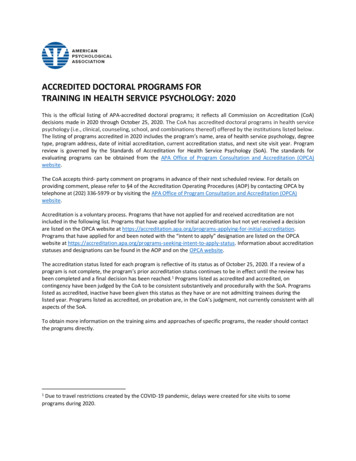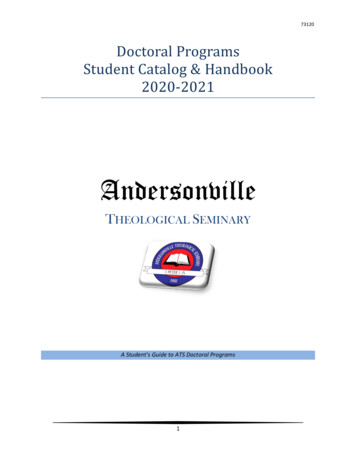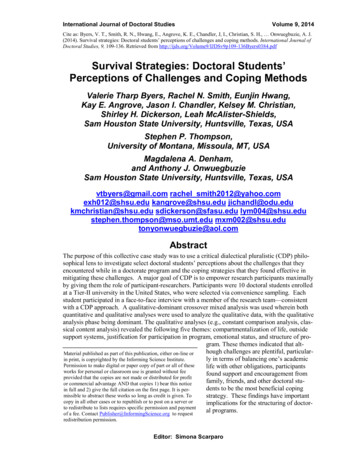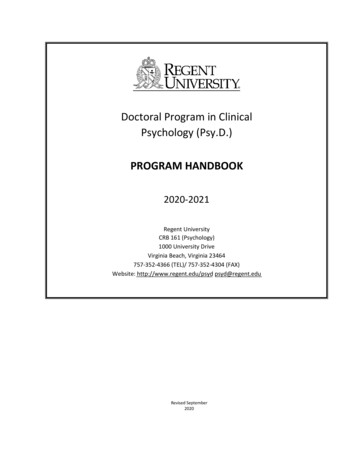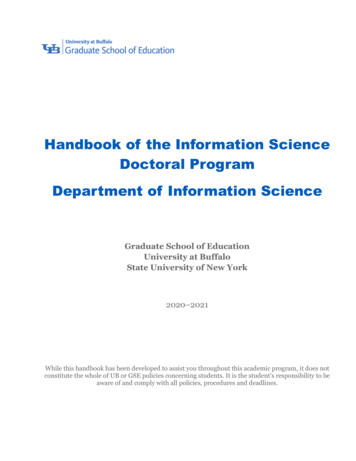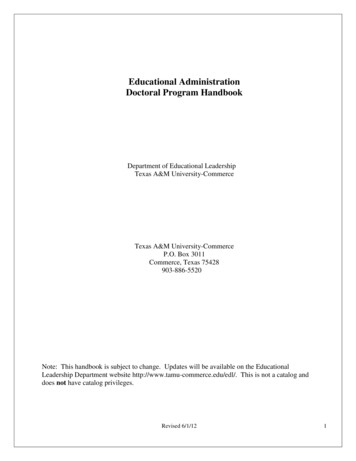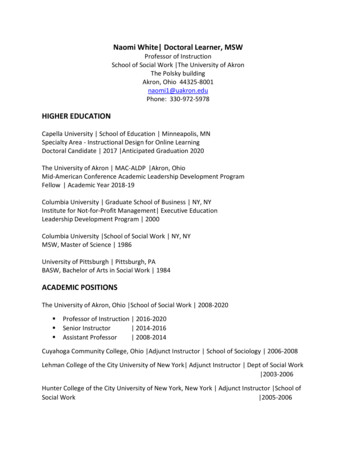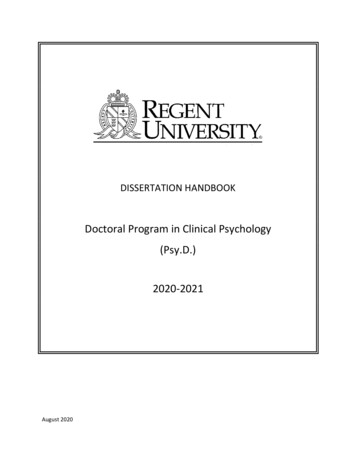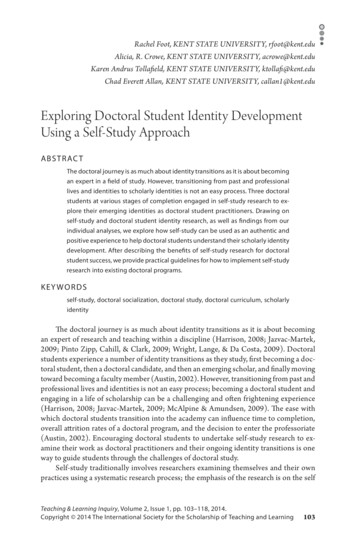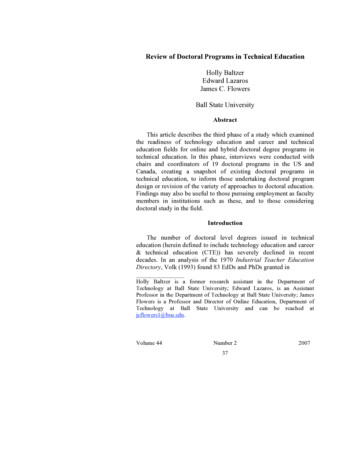
Transcription
Review of Doctoral Programs in Technical EducationHolly BaltzerEdward LazarosJames C. FlowersBall State UniversityAbstractThis article describes the third phase of a study which examinedthe readiness of technology education and career and technicaleducation fields for online and hybrid doctoral degree programs intechnical education. In this phase, interviews were conducted withchairs and coordinators of 19 doctoral programs in the US andCanada, creating a snapshot of existing doctoral programs intechnical education, to inform those undertaking doctoral programdesign or revision of the variety of approaches to doctoral education.Findings may also be useful to those pursuing employment as facultymembers in institutions such as these, and to those consideringdoctoral study in the field.IntroductionThe number of doctoral level degrees issued in technicaleducation (herein defined to include technology education and career& technical education (CTE)) has severely declined in recentdecades. In an analysis of the 1970 Industrial Teacher EducationDirectory, Volk (1993) found 83 EdDs and PhDs granted inHolly Baltzer is a former research assistant in the Department ofTechnology at Ball State University; Edward Lazaros, is an AssistantProfessor in the Department of Technology at Ball State University; JamesFlowers is a Professor and Director of Online Education, Department ofTechnology at Ball State University and can be reached atjcflowers1@bsu.edu.Volume 44Number 2372007
38JOURNAL OF INDUSTRIAL TEACHER EDUCATIONIndustrial Arts and Technology Education. This number declined to50 in his analysis of the 1990 edition. Based on this trend and otheranalyses, Volk (1997) predicted that a collapse of industrial artsteacher education programs would occur by 2005. Volk argued thatone factor in this predicted collapse is the lack of new ideas andinnovation at the university level. Rogers (2002) further analyzed thenumber of higher education graduates listed in the Industrial TeacherEducation Directory, this time in the 2000 edition, and founddoctoral degrees granted in technology education were at an all timelow with only 19 graduates. While Volk’s predicted collapse of thefield has not yet occurred, the steady decrease in graduates since1970 is alarming.Associated with the decrease in doctorates granted in technicaleducation, Reed (2002) noted a “disturbing trend” (p. 68). There was“a steady decline in graduate research” (p. 68) as evidenced by thenumber of theses and dissertations in technology education just asthis field was evolving from industrial arts, when research would beneeded the most. In addition, an alarming shortage of secondaryschool technology teachers across the nation and an increase inprogram closures at this level have also been observed (Bruening etal., 2001; Rogers, 2002; Volk, 1997; Wicklein, 1993). Also, anational (US) survey of 359 Career and Technical Education facultyby Bruening et al. (2001) found the average age of CTE faculty to bejust over 50, indicating “a flurry of retirements is likely at the end ofthis decade” (p. 51). If these retirements decrease the net number ofhigher education faculty, there may be an unmet need for morequalified educators in bachelor’s level programs. Furthermore, itseems logical to expect a decrease in the number of researchers, andtherefore in innovation in the field.A summation of the previous findings leads to a distressingpicture of the possible future for education and research within thefield of technical education. A lack of qualified professors atbachelor’s-granting institutions leads to a lack of qualified secondaryschool technology teachers. This ailing professional pipeline couldfurther aggravate technology program closures in middle and high
Review of Doctoral Programs in TE39schools. With fewer technology programs in secondary schools,fewer new teachers would be required. This could lead to technologyeducation program closures at the bachelor’s level, which decreasesthe demand for doctoral educated faculty in technical education. Adecline in the number of doctoral educated researchers in technicaleducation could lead to a decrease in innovation within the field(Volk, 1997). This is a problem because there is a “need to furtheridentify the working theories and concepts of technologyeducation in order for the field to move forward as a legitimateacademic discipline” (Wicklein, 1993, p. 70). Only through innovative change can this field hope to re-energize and begin to growagain.In order to better understand the decline in the number oftechnical education doctoral graduates, one must look at the factorsthat make up doctoral level education in the field. Paige, Dugger, andWolansky (1996) identified essential components of doctoral leveleducation in industrial technology education in order to, “determinehow doctoral programs may be redirected to meet contemporaryneeds of both students and the profession” (p. 19). They discovered afield, “grappling with inconsistencies in mission statements anddesired outcomes” (p. 20). But that study occurred over a decadebefore the present study, and in light of developments over that time(e.g., Standards for Technological Literacy, a growth in onlineeducation) questions are raised as to the present applicability of thatpast data in describing the field.The present study is the third phase of a larger investigation toinform the field on factors impacting the decision to offer online andhybrid doctoral degree programs. The first phase looked at theperceived need for new hires and hiring attitudes towards those whoearned their doctoral degree online (Flowers & Baltzer, 2006a). Thesecond phase looked at the perceived demand for an online or hybriddoctoral program in technical education (Flowers & Baltzer, 2006b).This third phase, as mentioned, examines the status of currentdoctoral programs in technical education. This snapshot of thecurrent state of doctoral programs in the field, taken eleven yearsafter the study by Paige, et al. (1996) addresses some of the samegoals by providing information that may help those with the task of
40JOURNAL OF INDUSTRIAL TEACHER EDUCATIONdeciding the future of doctoral education meet the changing needs ofstudents and faculty.MethodsConsidering the relatively small number of doctoral programs,the intimacy each program coordinator or department chair has withtheir program, and the likelihood of gathering unanticipatedinformation or information that leads to a re-direct of a question,telephone interviewing with program coordinators and chairs wasused to gather information not provided on program websites. Thesample for this study included chairs and coordinators of PhD orEdD programs in technical education and related fields. Theseprograms were found using the following resources: the IndustrialTeacher Education Directory for 2005-2006 (Schmidt & Custer,2005), and online searches at www.petersons.com andwww.gradschools.com. Twenty-three programs were then verifiedto have these degrees and the chairs and coordinators of theprograms were identified at the institution’s website. The chair ordoctoral program coordinator at 19 (82.6%) of these institutionsagreed to participate (Table 1), though some declined to respond toone or more specific interview question, resulting in a lower numberthan 19 responses for several items. Two of the institutions were inCanada, and the rest were located in the United States. Theinvestigators only encountered one institution that had multipleprograms of interest with different coordinators listed. In this case,the contact from the field more closely related to technical educationwas identified as more appropriate.Table 1Participating Doctoral Programs (n 19)Clemson UniversityPhD and EdD in Workforce Education and index/index ind.aspIndiana State UniversityPhD in Technology Managementhttp://www.indstate.edu/consortphd/
Review of Doctoral Programs in TE41Table 1 (continued)North Carolina State UniversityEdD in Technology Educationhttp://ced.ncsu.edu/mste/tech programs/tedd.htmlOklahoma State UniversityPhD in Education with option in Occupational Education udies/phd.htmOld Dominion UniversityPhD in Education with a concentration in Occupational andTechnical /phd.shtmlPurdue UniversityPhD in Curriculum & Instruction with a concentration inCareer & Technical Educationhttp://www.edci.purdue.edu/grad studies/degrees.html#PhDSouthern Illinois University CarbondalePhD in Education with a concentration in Workforce e Ohio State UniversityPhD in Integrated Mathematics, Science, and Technology rees.htmlUniversity of British ColumbiaPhD and EdD in Curriculum Studies with a concentration dmissions/doctor.htmlUniversity of GeorgiaPhD and EdD in Workforce rograms/grad.htmlUniversity of ManitobaPhD in Education with an area in Technology or TechnologyEducationhttp://umanitoba.ca/graduate studies/programs/phd/education/index.htmUniversity of MinnesotaPhD and EdD in Work & Human Resource tor.html
42JOURNAL OF INDUSTRIAL TEACHER EDUCATIONTable 1 (continued)University of Nevada-Las VegasPhD Higher Education, Workforce Education and ew design/highered/doctoral/index.htmlUniversity of North TexasPhD and EdD in Applied Technology and Performance Improvementhttp://www.coe.unt.edu/LT/ATTD/api dr.phpUniversity of South FloridaPhD in Curriculum & Instruction with a concentration in Career andWorkforce Ed.http://www.coedu.usf.edu/main/programs.htmlUtah State UniversityPhD and EdD in Education (Curr. & Instr.), emphasis in Engineeringand Technology Valdosta State UniversityEdD in Adult & Career Educationhttp://www.valdosta.edu/coe/edd/COE Doctoral Programs/COEDoctoralPrograms.shtmlVirginia Polytechnic Institute and State UniversityPhD and EdD in Curriculum & Instruction with a concentration inTechnology htmlWestern Michigan UniversityPhD in Educational Leadership (CTE toral/index.htmData collection was by telephone interviews between the subjectand one of two interviewers in 2006 and 2007. This was deemed themost appropriate method due to the depth of information beingsought and the desire by the investigators to attain both anonymousand non-anonymous information. An interview script was developedand pilot tested with the goal of identifying program ducation,andobstacles/solutions associated with each doctoral program.Interviews generally followed the script, although each interview
Review of Doctoral Programs in TE43was a unique dialog that often included unscripted discussions.Following human subjects protocol approval, an invitation toparticipate was sent to the subjects to ask for participation and toverify contact information.All data was entered into a Microsoft Access database during thephone interview. The data was later organized in a Microsoft Excelspreadsheet for analysis. Descriptive statistics were calculated forquantitative data to characterize the field. Since the data was fromtelephone interviews and often based on opinion, inferential statisticswere not calculated. Qualitative data was analyzed by firstidentifying themes for items asking about obstacles, solutions,opportunities and recommendations. This was done independently byat least two researchers. Keywords and phrases were used to obtainan initial list of themes; these were collapsed to a smaller number.For examples, several respondents noted insufficient faculty size wasan obstacle for their program, some wording this in terms of funding,some in terms of administrative support for more faculty, and somein terms of the inadequacy of the number of faculty given theirnumber of students. This was collapsed into the category, “Too fewfaculty and staff; too many students,” realizing that someinformation is lost during this collapse. The identification of initialthemes, final themes, and the association of a response with a themewere compared between researchers and discussed until consensuswas reached. Qualitative data was coded in Microsoft Excel withnumerical identifiers that labeled the themes. Frequency counts ofthe themes were tabulated and interesting or important commentswere quoted and presented.Results and DiscussionThe data from this study is divided into four main types ofinformation that are related but distinct. First, programcharacteristics and future directions of the programs are summarized.This is followed by a section dealing with current and futurevacancies and hiring trends. Third, the amount of current andpredicted incorporation of distance delivery elements into the
44JOURNAL OF INDUSTRIAL TEACHER EDUCATIONprogram is discussed. Last, there is a section characterizing historicand current obstacles, possible solutions and other opportunities.Program CharacteristicsOf the 19 institutions represented in this sample, ten had PhDprograms only, two had EdD programs only, and seven had both aPhD and an EdD program in technical education (Table 1). One wasa consortium program where doctoral students engaged incoursework at multiple consortium-member universities. Somestatistical calculations in this study excluded data from thatconsortium, as indicated later, because it characterized multipleuniversities. The mean number of full time doctoral students was45.1 (SD 41.2, n 15). After removing consortium data, the meanwas 37.4 (SD. 27.4, n 14, range 5 to 82). The mean number ofdoctoral faculty was 10.9 (SD 11.1, n 15, range 1 to 40). Thisis a ratio of 3.4 full time doctoral students per faculty, although thisoverlooks other faculty assignments. Lastly, seven respondentsreported that their doctoral enrollment was growing, eight reportedtheir enrollment was stable, and three reported their enrollment wasshrinking.Themes and Future DirectionsRespondents were asked to characterize the theme of theirprogram (see Table 2). The most common theme of educationalstudies included items such as curriculum, instruction, andeducational leadership. In spite of the requirement of a dissertation,only three of the respondents specifically mentioned research as atheme of their doctoral program (which may be troubling in light ofthe need for more research and researchers (Paige, et al., 1996; Reed,2002; Volk, 1997).Deal, Ndahi, Reed, and Ritz (2006) surveyed technologyeducation programs at universities and identified themes for studentresearch, a topic not addressed in the current study. Themes theyuncovered included, “engineering education, effects of technology,action research—technology education, technological literacy, value
Review of Doctoral Programs in TE45of technology, [and] cognition & teacher education.” While themesfor student research and themes for doctoral programs are clearlydistinct, it is interesting to see that engineering education, research,and teacher education can be seen in both studies.Table 2“What is the primary theme, or what setsapart the respondents doctoral program?”(n 17, multiple responses were possible)Educational Studies6Research3STEM integration2Private Sector2Technical/industrial2Student-centered program2Technology and Society1Respondents were asked how their program is evolving and whatnew directions the program is pursuing (Table 3). While 17 of 19respondents to this item indicated that change is occurring, fiveremarked that their program was currently undergoing major overallchanges. The most prominent new directions were Science,Technology, Engineering, Mathematics (STEM) integration and anincreased emphasis on research (e.g., “More rigorous research.”“Increasing research requirements, specifically adding qualitativeresearch.”). However, the low numbers even for these areas indicatea great diversity in the direction various doctoral programs aretaking. If most respondents indicated the same theme for theirprogram evolution (such as STEM or addressing new nationalstandards), a picture would have emerged of a more unified and lessfragmented state of doctoral education in the field. Interestingly,several respondents indicated their program was changing from anEdD to a PhD program, with one indicating their change wasmotivated by a lack of credibility for an EdD outside the UnitedStates.
46JOURNAL OF INDUSTRIAL TEACHER EDUCATIONTable 3How is the respondent’s program evolving or whatnew directions is the program taking? (n 17,multiple responses were possible)STEM4Research4Introducing online elements3Improving quality of teaching and curriculum3Attracting international students3Changing from an EdD to a PhD3Workforce training2Leadership1Faculty Vacancies and Hiring CriteriaThe average number of current full-time faculty vacancies perdepartment was 1.2 (SD 1.3, n 15). The average for contractfaculty was 0.5 (SD 1.2, n 12). These results are consistent with aprevious study done by these investigators that surveyed programs intechnical education with only masters or bachelors level programs;that survey asked about tenure versus non-tenure track positions andfound the current average tenure track vacancies to be 1.0 and nontenure track vacancies to be 0.22 (Flowers & Baltzer, 2006a).The predicted number of vacancies for full time faculty over thenext 5 years ranged from 0 to 30, with an average of 5.0 (SD 7.2, n 15), or 1.0 per year. For contract faculty over the next five yearsthe average was 3.3 (SD 3.6, n 9), or .72 per year. The surveypreviously mentioned (Flowers & Baltzer, 2006a) also asked aboutanticipated vacancies for tenure and non-tenure track faculty.However, the 2006 survey asked the respondents to estimatevacancies for the next three years. The results were an average of 2.0tenure track vacancies (.67 per year) and an average of 0.7 nontenure track vacancies (.23 per year). These results seem to indicatemore projected vacancies per department for doctoral institutions
Review of Doctoral Programs in TE47than for those that offer only bachelor’s or master’s degrees.However, the large standard deviations found in the present studyindicate a great deal of variability within doctoral institutions forboth current and projected vacancies. Hiring criteria were also foundto vary among doctoral institutions (Table 4). The most frequentlycited criterion concerned research and publications, which is notsurprising considering the sample was doctoral programs.Table 4Main Hiring Criteria for a Tenure Track Position (n 16,multiple responses were possible)Research and publications11Holds a terminal degree6Teaching experience or formal teaching preparation5Industry experience5Personality and fit3Specifically public school teaching experience3Service2Grants and funding2Enthusiasm and dedication2Knowledge of distance education technologies1Knowledge of state educational law and mandates1Good recommendations1A potential hire, while being concerned with the hiring criteria,may also be concerned with expectations for their performance.Traditionally, teaching load and the balance among research,teaching, and service activities are considered by a prospectivefaculty member prior to accepting a position. For this reason, morespecific items were asked to uncover the variety among these factorsat doctoral institutions in the field. The teaching load varied from 1.5to 4 three-credit courses per semester with a mean of 2.56. Thereported teaching load was two courses per semester at eightinstitutions in this samp
Review of Doctoral Programs in Technical Education Holly Baltzer Edward Lazaros James C. Flowers Ball State University Abstract This article describes the third phase of a study which examined the readiness of technology education and career and technical education fields for online and hybrid doctoral
